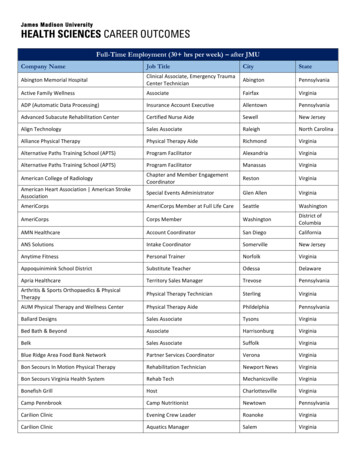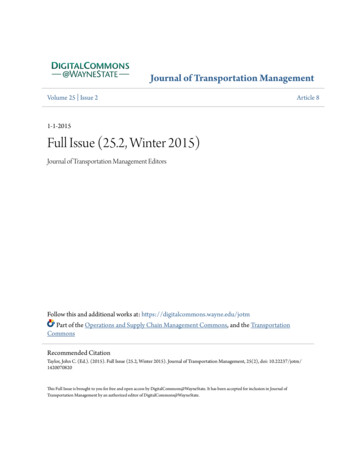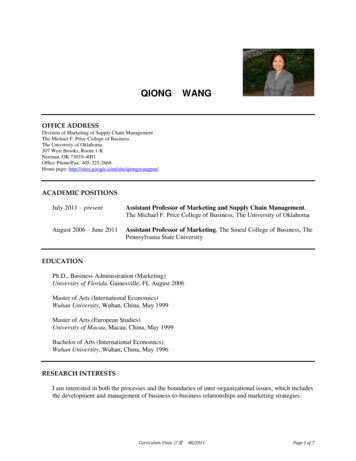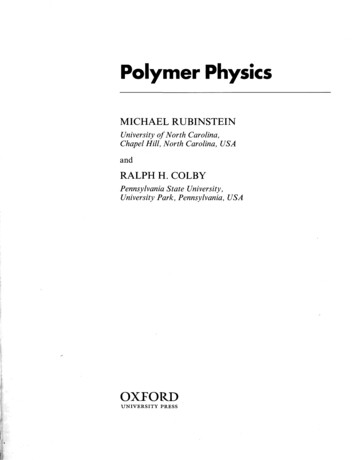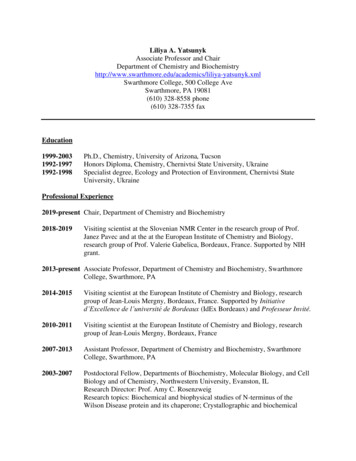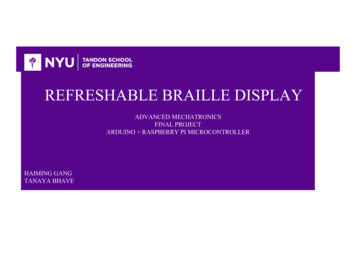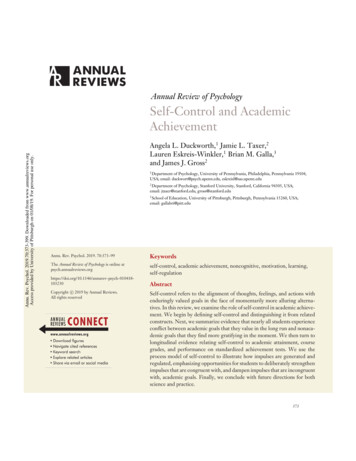
Transcription
ions
This page left intentionally blank for printing.
ionsThe Pennsylvania Housing Research CenterUniversity Park, Pennsylvania
2018 by the Pennsylvania Housing Research Center (PHRC)All rights reserved. For more information, contact the Pennsylvania Housing Research Center, 206B SackettBuilding, University Park, PA 16802.Published October 2018, Second EditionPrinted in the United States of AmericaDISCLAIMER: The Pennsylvania Housing Research Center (PHRC) serves the home building industry andthe residents of Pennsylvania by improving the quality and affordability of housing. The PHRC conductsapplied research, fosters the development and commercialization of innovative technologies, and transfersappropriate technologies to the housing community. The PHRC is housed within the Department of Civil& Environmental Engineering at Penn State. The PHRC conducts operations with the support of numerousagencies, associations, companies, and individuals. Neither the PHRC, nor any of its supporters, makesany warranty, expressed or implied, as to the accuracy or validity of the information contained in thisdocument. Similarly, neither the PHRC, nor its sponsors, assumes any liability for the use of the informationand procedures provided in this document. Opinions, when expressed, are those of the authors and donot necessarily reflect the views of either the PHRC or anyone of its sponsors. It would be appreciated,however, if any errors of fact or interpretation or otherwise, could be promptly brought to the attention ofPHRC. If additional information is required, contact:Brian WolfgangAssociate DirectorPHRC206C Sackett BuildingUniversity Park, PA 16802
ACKNOWLEDGMENTSThe development of the 2018 Pennsylvania Alternative Residential Energy Provisions (PA-Alt) was led by thePHRC with guidance from a subcommittee of the PHRC Industry Advisory Council. The PHRC would like torecognize the following members of the PA-Alt Subcommittee for their contribution of time and knowledge:Bob Hart Amy MartinoJohn Holahan Tom McCosbyJon Kautz Sarah MillerJerry Leach Chad OwensGary Lenker Tommy SongerRobin Loughran Jon SukonikR. Clem Malot Mike TurnsFinancial support for work on the development of this document was provided by the Commonwealth ofPennsylvania and the Pennsylvania Department of Community and Economic Development through fundscollected under Act 157 of 2007 and amended by Act 36 of 2017, the Bernard and Henrietta Hankin Chairin Residential Building Construction endowment, the Pennsylvania State University, and the members ofthe PHRC.This document was developed by Brian Wolfgang, associate director; Christopher Hine, housing &land development specialist; and Sarah Klinetob Lowe, housing systems specialist of the PHRC. Energyequivalence analysis was performed by Sarah Klinetob Lowe. The document design and formatting wasdone by Rachel Fawcett, budgets & publications coordinator of the PHRC.The 2018 Pennsylvania Alternative Residential Energy Provisions were developed by the PHRC as a serviceto the Pennsylvania Department of Labor and Industry on behalf of all the consumers of housing inPennsylvania.
This page left intentionally blank for printing.
TABLE OF CONTENTS1. PREFACE vii2. SECTION PA100 1GENERAL3. SECTION PA200 5CLIMATE ZONES4. SECTION PA300 7BUILDING THERMAL ENVELOPE5. SECTION PA400 15SYSTEMS6. SECTION PA500 19ELECTRICAL POWER AND LIGHTING SYSTEMS
This page left intentionally blank for printing.vi
PREFACEIn November 1999, the Pennsylvania Legislature passed Act 45, known as the Uniform Construction Code(UCC), into law mandating a statewide building code across Pennsylvania. Act 45 requires the PennsylvaniaDepartment of Labor and Industry (DLI) to promulgate regulations to implement the requirements of thelegislation and in addition, to consider the development of alternative prescriptive methods for energyconservation that account for the various climatic regions within the Commonwealth. In deriving theseenergy standards, the DLI was to seek to balance energy savings with initial construction costs.The PHRC developed Pennsylvania Alternative Residential Energy Provisions (PA-Alt) for consideration byDLI to meet their legislated mandate. The PA-Alt was developed with the intent of being: simpler to build to and easier to enforce; more rational and flexible; focused on Pennsylvania in terms of climatic and other conditions; and, equivalent to the provisions of the International Energy Conservation Code (IECC).The initial version of the PA-Alt was developed in 2000 and was based on the 2000 IECC and InternationalResidential Code (IRC). The second, third, and fourth versions were updated to the 2003, 2006, and 2009IECC and IRC, respectively. This document is the fifth iteration of the PA-Alt, and it is equivalent to the 2015IECC and IRC.The Pennsylvania Alternative Residential Energy Provisions document is an alternative to chapter 11 of theIRC. It is intended to supplement the IRC and to the extent possible, be consistent in format and generalintent. The scope and definitions used in the IRC apply. It is important to note that a choice needs to bemade by the builder or design professional between the 2018 PA-Alt, the 2015 IRC, and the 2015 IECC.vii
This page left intentionally blank for printing.viii
SECTION PA100GENERALPA101 Scope. The provisions of this document regulate energy efficiency for the design and constructionof buildings regulated by the 2015 International Residential Code (IRC) as incorporated in the PA UniformConstruction Code (UCC) in the Commonwealth of Pennsylvania.Exception: Portions of the building envelope that do not enclose conditioned space.PA102 Intent. This document was developed with the intent of being: simpler to build and easier toenforce; more rational and flexible; focused on Pennsylvania in terms of climatic and other conditions;and, equivalent to the provisions of the International Energy Conservation Code (IECC) in terms of energyefficiency as incorporated in the UCC.PA103 Compliance. Compliance shall be demonstrated by either meeting the requirements of the IECCor the IRC, as incorporated in the UCC, or meeting the requirements of this document. Climate zones fromPA201 shall be used in determining the applicable requirements from this document.PA104 Entrance requirements. This compliance path allows for some reductions in energy efficiencythat will allow simplified enforcement and construction. To utilize the PA Alternative Energy Provisions,the building owner or agent must choose at least one of the energy enhancement options in Table PA104.Table PA104Energy Enhancement OptionsOptionMinimum efficiency by climate zoneDescriptionSouth (4)Central (5)North (6)8.5 HSPF8.5 HSPF8.5 HSPFCompliantCompliantCompliant1.4 kW1.7 kW3.4 kWCompliantCompliantCompliant1Ductless heat pumps2All air ducts located inside the thermal envelope3Solar photovoltaic system installed4Geothermal or water source heat pump installed5Improved efficiency air source heat pump installed8.7 HSPF9.0 HSPF10.0 HSPF6Improved efficiency furnace installed90 AFUE90 AFUE90 AFUE7Exterior continuous insulationR20 10R20 108Improved airtightness3.0 ACH503.0 ACH503.0 ACH509Improved efficiency windowsU-factor 0.25U-factor 0.23U-factor 0.19U-factor 0.27U-factor 0.25U-factor 0.25R-value 60R-value 60R-value 60U-factor 0.27U-factor 0.25U-factor 0.23CompliantCompliantCompliant1011Package: Improved efficiency windows andhigher attic R-value with raised heel trussaPackage: Improved efficiency windows andheat pump water heaterWindowsAtticWindowsHeat PumpWater HeaterNotes:a. Full height of uncompressed insulation shall extend over the top plate at the eaves.1
PA105 Compliance documents. If this document is used for energy compliance, it must be clearlyidentified on construction documents or listed on the application for a building permit. Additionally, theoption used to meet the entrance requirements in PA104 must be identified.PA106 Definitions. To minimize confusion, the definitions contained in Chapter 2[RE] of the 2015 IECC orSection N1101.6 of the 2015 IRC apply to this document.PA107 Identification. Materials, systems, and equipment shall be identified in a manner that will allow adetermination of compliance with the applicable provisions of this chapter.PA108 Building thermal envelope insulation. An R-value identification mark shall be applied by themanufacturer to each piece of building thermal envelope insulation 12 inches (305 mm) or more wide.Alternately, the insulation installers shall provide a certification listing the type, manufacturer and R-valueof insulation installed in each element of the building thermal envelope. For blown or sprayed insulation(fiberglass and cellulose), the initial installed thickness, settled thickness, settled R-value, installed density,coverage area and number of bags installed shall be listed on the certification. For sprayed polyurethanefoam (SPF) insulation, the installed thickness of the area covered and R-value of installed thickness shallbe listed on the certificate. For insulated siding, the R-value shall be labeled on the product’s packageand shall be listed on the certification. The insulation installer shall sign, date and post the certificate in aconspicuous location on the job site.PA108.1 Blown or sprayed roof/ceiling insulation. The thickness of blown in or sprayed roof/ceiling insulation (fiberglass or cellulose) shall be written in inches (mm) on markers that are installedat least one for every 300 ft2 (28 m2) throughout the attic space. The markers shall be affixed to thetrusses or joists and marked with the minimum initial installed thickness with numbers a minimumof 1 inch (25 mm) high. Each marker shall face the attic access opening. Spray polyurethane foamthickness and installed R-value shall be listed on the certificate provided by the insulation installer.PA108.2 Insulation mark installation. Insulating materials shall be installed such that themanufacturer’s R-value mark is readily observable upon inspection.PA109 Fenestration product rating. U-factors of fenestration products (windows, doors and skylights)shall be determined in accordance with NFRC 100 by an accredited, independent laboratory, and labeledand certified by the manufacturer. Products lacking such a labeled U-factor shall be assigned a defaultU-factor from 2015 IRC Tables N1101.10.3(1) [R303.1.3(1)] and N1101.10.3(2) [R303.1.3(2)].PA110 Insulation product rating. The thermal resistance (R-value) of insulation shall be determined inaccordance with the CFR Title 16, Part 460, in units of h ft2 F/Btu at a mean temperature of 75 F (24 C),installer shall sign, date and post the certificate in a conspicuous location on the job site.PA110.1 Insulated Siding. The thermal resistance (R-value) of insulated siding shall be determined inaccordance with ASTM C1363. Installation for testing shall be in accordance with the manufacturer’sinstallation instructions.PA111 Installation. All materials, systems and equipment shall be installed in accordance with themanufacturer’s installation instructions and the provisions of this code.PA111.1 Protection of exposed foundation insulation. Insulation applied to the exterior ofbasement walls, crawl space walls, and the perimeter of slab-on-grade floors shall have a rigid,opaque and weather-resistant protective covering to prevent the degradation of the insulation’sthermal performance. The protective covering shall cover the exposed exterior insulation andextend a minimum of 6 inches (152 mm) below grade.PA112 Maintenance information. Maintenance instructions shall be furnished for equipment and systemsthat require preventative maintenance. Required regular maintenance actions shall be clearly stated and2
incorporated on a readily accessible label. The label shall include the title or publication number for theoperation and maintenance manual for that particular model and type of product.PA113 Above code programs. The building official or other authority having jurisdiction shall be permittedto deem a national, state or local energy efficiency program to exceed the energy efficiency required bythis document. Buildings approved in writing by such an energy efficiency program shall be considered incompliance with this document.PA114 Certificate. A permanent certificate shall be posted on or in the electrical distribution panel. Thecertificate shall not cover or obstruct the visibility of the circuit directory label, service disconnect label orother required labels. The certificate shall be completed by the builder or registered design professional. Thecertificate shall list the predominant R-values of insulation installed in or on ceiling/roof, walls, foundation(slab, basement wall, crawlspace wall and/or floor) and ducts outside conditioned spaces; U-factors forfenestration; and the solar heat gain coefficient (SHGC) of fenestration. Where there is more than onevalue for each component, the certificate shall list the value covering the largest area.The certificate shall list the types and efficiencies of heating, cooling and service water heating equipment.Where a gas-fired unvented room heater, electric furnace and/or baseboard electric heater is installed inthe residence, the certificate shall list “gas-fired unvented room heater,” “electric furnace” or “baseboardelectric heater,” as appropriate. An efficiency shall not be listed for gas-fired unvented room heaters,electric furnaces or electric base board heaters.3
This page left intentionally blank for printing.4
SECTION PA200CLIMATE ZONESPA201 General. Climate zones listed in PA201.1 shall be used.PA201.1 Climate ZonesSouth (4): Bucks, Chester, Delaware, Montgomery, Philadelphia, YorkCentral (5): All other countiesNorth (6): Cameron, Clearfield, Elk, McKean, Potter, Susquehanna, Tioga, WayneNorth (6)Central (5)Figure PA201.1Pennsylvania Climate ZonesSouth (4)Image Source: https://energycode.pnl.gov/EnergyCodeReqs/?state Pennsylvania5
This page left intentionally blank for printing.6
SECTION PA300BUILDING THERMAL ENVELOPEPA301 Insulation and fenestration criteria. The building thermal envelope shall meet the requirementsof Table PA301 based on the climate zone specified in PA201.PA301.1 R-value computation. Insulation material used in layers, such as framing cavity insulationand insulating sheathing, shall be summed to compute the component R-value. The manufacturer’ssettled R-value shall be used for blown insulation. Computed R-values shall not include an R-valuefor other building materials or air films. Where insulated siding is used for the purpose of complyingwith the continuous insulation requirements of Table PA301, the manufacturer’s labeled R-value forinsulated siding shall be reduced by R-0.6.Table PA301Insulation and Fenestration Requirements by ComponentabGlazedCeilingWood FrameMass WallFloorR-valueWall R-valueR-valuecR-value0.43820 or 13 5g8/130.55NR4920h or 13 U-factorSouth (4)0.350.55Central (5)0.32North (6)0.32FenestrationSHGCh23, 20 5, 18 6.5,or 13 nd depthR-value1910/1310, 2 ft10/1313/1730f10/1310, 2 ft10/1315/2030f10/1310, 4 ft15/19Notes:a. R-values are minimums. U-factors and solar heat gain coefficient (SHGC) are maximums. R-19 batts compressed in to nominal 2 x6 framing cavity such that the R-value is reduced by R-1 or more shall be marked with the compressed batt R-value in addition tothe full thickness R-value.b. The fenestration U-factor column excludes skylights.c.The second R-value applies when more than half the insulation is on the interior.d. The first R-value applies to continuous insulation on the interior or exterior of the home, the second to framing cavity insulationat the interior of the basement wall; either insulation meets the requirement.e. R-5 shall be added to the required slab edge R-values for heated slabs.f.Or insulation sufficient to fill the framing cavity, R-19 minimum. Floor insulation may also be reduced to R-19 if installed above anunconditioned basement.g. “13 5” means R-13 cavity insulation plus R-5 insulated sheathing. If structural sheathing covers 40% or less of the exterior,continuous insulation R-value shall be permitted to be reduced by no more than R-3 in the locations where structural sheathingis used – to maintain a consistent total sheathing thickness.h. R-18 insulation shall be permitted in place of R-20 requirement provided the wall framing factor is 20% or less or exterior wallswith 24” o.c. nominal vertical stud spacing.PA302 Specific insulation requirements.PA302.1 Ceilings with attic spaces. When Section PA301 would require R-38 in the ceiling, R-30shall be deemed to satisfy the requirement for R-38 wherever the full height of uncompressed R-30insulation extends over the wall top plate at the eaves. Similarly R-38 shall be deemed to satisfy therequirement for R-49 wherever the full height of uncompressed R-38 insulation extends over thewall top plate at the eaves.Figure PA302.1Ceiling With Full-Height UncompressedInsulation Above the Top Plate7
PA302.2 Ceilings without attic spaces. Where the design of the roof/ceiling assembly does notallow sufficient space for the required insulation, such as cathedral ceilings, the minimum requiredinsulation for such roof/ceiling assemblies shall be R-30.Figure PA302.2Ceiling Without Attic SpacesPA302.3 Access hatches and doors. Access hatches and doors from conditioned spaces tounconditioned spaces (e.g., attics and crawl spaces) shall be weather stripped. Both vertical andhorizontal access hatches shall be insulated to a minimum of R-20 with rigid foam permanentlyattached to the access hatch. This is not intended to restrict the use of proprietary products meetingthe intent of this provision. Side hinged access door shall meet the fenestration requirements ofTable PA301.A wood framed or equivalent baffle or retainer is required to be provided when loose fill insulationis installed. The purpose of which is to prevent the loose fill insulation from spilling into the livingspace when the attic access is opened. Areas around access hatches required to service equipmentshall provide a permanent means of maintaining the installed R-value of the insulation.Exception: Vertical doors that provide access from conditioned to unconditioned spacesshall be permitted to meet the fenestration requirements of Table PA301 based on theapplicable climate zone specified in section PA201.1.Insulation BaffleR-20Figure PA302.3 (1)Attic HatchR-20Figure PA302.3 (2)Pull-Down Stairs8
PA302.4 Mass walls. Mass walls, for the purposes of this chapter, shall be considered above-gradewalls of concrete block, concrete, insulated concrete form (ICF), masonry cavity, brick (other thanbrick veneer), earth (adobe, compressed earth block, rammed earth) and solid timber/logs, or anyother walls having a heat capacity greater than or equal to 6 Btu/ft2x F (123 kJ/m2xK)PA302.5 Floors. Floor insulation shall be installed to maintain permanent contact with the undersideof the subfloor decking.Exception: The floor framing-cavity insulation shall be permitted to be in contact with thetopside of sheathing or continuous insulation installed on the bottom side of floor framingwhere combined with insulation that meets or exceeds the minimum wood frame wallR-value in Table PA301 and that extends from the bottom to the top of all perimeter floorframing members.PA302.6 Basement walls. Exterior walls associated with conditioned basements shall be insulatedfrom the top of the basement wall down to 10 feet (3048 mm) below grade or to the basement floor,whichever is less. Walls associated with unconditioned basements shall meet this requirementunless the floor overhead is insulated in accordance with Sections PA301.PA302.7 Slab-on-grade floors. Slab-on-grade floors with a floor surface less than 12 inches (305mm) below grade shall be insulated in accordance with Table PA301. The insulation can be installedon either the exterior or interior of the foundation wall.PA302.7.1 Exterior Insulation. Exterior insulation shall be installed from the top of the slaband extend below grade the distance listed in Table PA301 by any combination of verticalinsulation or horizontal insulation extending away from the building. Insulation extendingaway from the building shall be protected by pavement or by a minimum of 10 inches (254mm) of soil. Insulation shall also meet PA 111.1.External InsulationProtection fromPhysical DamageFigure PA302.7.1Exterior Slab Insulation9
PA302.7.2 Interior Insulation. Interior insulation shall be installed from the bottom of theslab and extend the distance provided in Table PA301 by any combination of vertical insulationor horizontal insulation extending under the slab. The slab edge shall be separated from thefoundation wall by a continuous ½ inch thermal break as per Figure PA302.8.(2) A thermalbreak shall be created by a material suitable for ground contact, which includes, but is notlimited to, asphalt impregnated fiber board or extruded polystyrene. Slab-edge insulation isnot required in jurisdictions designated by the code official as having a very heavy termiteinfestation.Thermal BreakInternal InsulationFigure PA302.7.2Interior Slab InsulationPA302.8 Crawl space walls. As an alternative to insulating floors over crawl spaces, insulation ofcrawl space walls shall be permitted when the crawl space is not vented to the outside. Crawl spacewall insulation shall be permanently fastened to the wall and extend downward from the floor tothe finished grade level and then vertically and/or horizontally for at least an additional 24 inches(610 mm). Exposed earth in unvented crawl space foundations shall be covered with a continuousClass I vapor retarder. All joints of the vapor retarder shall overlap by 6 inches (152 mm) and besealed or taped. The edges of the vapor retarder shall extend at least 6 inches (152 mm) up the stemwall and shall be attached to the stem wall.PA302.9 Masonry veneer. Insulation shall not be required on the horizontal portion of thefoundation that supports a masonry veneer.PA302.10 Thermally isolated sunroom insulation. The minimum ceiling insulation R-valuesshall be R-24. The minimum wall R-value shall be R-13. New wall(s) separating the sunroom fromconditioned space shall meet the building thermal envelope requirements.10
PA303 Fenestration.PA303.1 U-factor. An area-weighted average of fenestration products shall be permitted to satisfythe U-factor requirements.PA303.2 Glazed Fenestration SHGC. An area-weighted average of fenestration products morethan 50% glazed shall be permitted to satisfy the SHGC requirements.PA303.3 Glazed fenestration exemption. Up to 15 square feet (1.4 m2) of glazed fenestration perdwelling unit shall be permitted to be exempt from U-factor requirements Table PA301.PA303.4 Opaque door exemption. One door assembly, including side hinged opaque doors,sidelights and transoms, up to 54 square feet (5.02 m2) in area is exempted from the U-factorrequirement in Table PA301.PA303.5 Thermally isolated sunroom U-factor. Maximum fenestration U-factor shall be 0.45 andthe maximum skylight U-factor shall be 0.70. New windows and doors separating the sunroom fromconditioned space shall meet the building thermal envelope requirements.PA303.6 Replacement fenestration. Where some or all of an existing fenestration unit is replacedwith a new fenestration product, including sash and glazing, the replacement fenestration unit shallmeet the applicable requirements for U-factor in Table PA301.PA304 Air leakage.PA304.1 Building thermal envelope. The building thermal envelope shall be durably sealed to limitinfiltration. The sealing methods between dissimilar materials shall allow for differential expansionand contraction.PA304.1.1. Installation. The components of the building thermal envelope as listed inTable PA304.1.1 shall be installed in accordance with the manufacturer’s instructions andthe criteria listed in Table PA304.1.1, as applicable to the method of construction. Whererequired by the building official, an approved third party shall inspect all components andverify compliance.PA304.1.2 Testing. The building or dwelling unit shall be tested and verified as having anair leakage rate or not exceeding five air changes per hour. Testing shall be conducted inaccordance with RESNET/ICC 380, ASTM E 779, or ASTM E 1827 and reported at a pressure of0.2 inches w.g. (50 Pascals). Where required by the code official, testing shall be conductedby an approved third party. A written report of the results of the test shall be signed by theparty conducting the test and provided to the code official. Testing shall be performed at anytime after the creation of all penetrations of the building thermal envelope.During testing:1. Exterior windows and doors, fireplace and stove doors shall be closed, but not sealed,beyond the intended weatherstripping or other infiltration control measures.2. Dampers shall be closed, but not sealed beyond intended infiltration controlmeasures; including exhaust, intake, makeup air, back draft, and flue dampers;3. Interior doors, if installed at the time of test, shall be open;4. Exterior openings for continuous ventilation systems and heat recovery ventilatorsshall be closed and sealed;5. Heating and cooling system(s), if installed at the time of the test, shall be turned off;6. Supply and return registers, if installed at the time of the test, shall be fully open.11
Table PA 304.1.1Air Barrier and Insulation InstallationComponentAir Barrier CriteriaInsulation Installation CriteriaA continuous air barrier shall be installed in the building envelope.General requirementsThe exterior thermal envelope contains a continuous air barrier.Air-permeable insulation shall not be used as a sealing material.Breaks or joints in the air barrier shall be sealed.Ceiling / atticThe air barrier in any dropped ceiling / soffit shall be aligned with theinsulation and any gaps in the air barrier sealed.Access openings, drop down stairs or knee wall doors to unconditionedattic spaces shall be sealed.WallsThe insulation in any dropped ceiling / soffit shall be aligned withthe air barrier.The junction of the foundation and sill plate shall be sealed.Cavities within corners and headers of frame walls shall be insulatedby completely filling the cavity with a material having a thermalsresistance of R-3 per inch minimum.The junction of the top plate and the top of exterior walls shall besealed.Exterior thermal envelope insulation for framed walls shall beinstalled in substantial contact and continuous alignment with theair barrier.Knee walls shall be sealed.Windows, skylights and doorsThe space between window / door jambs and framing, and skylightsand framing shall be sealed.Rim joistsRim joists shall include the air barrier.Rim joists shall be insulated.Floors (including above garageand cantilever floors)The air barrier shall be installed at any exposed edge of insulation.Floor framing cavity insulation shall be installed to maintainpermanent contact with the underside of subfloor decking, or floorframing cavity insulation shall be permitted to be in contact withthe top side of sheathing, or continuous insulation installed on theunderside of floor framing; and extends from the bottom to the topof all perimeter floor framing members.Crawl space wallsExposed earth in unvented crawl space shall be covered with a Class Ivapor retarder with overlapping joints taped.Where provided instead of floor insulation, insulation shall bepermanently attached to the crawl space walls.Shafts, penetrationsDuct shafts, utility penetrations, and flue shafts opening to exterior orunconditioned space shall be sealed.Batts in narrow cavities shall be cut to fit, or narrow cavities shall befilled by insulation that on installation readily conforms to theavailable cavity space.Narrow cavitiesGarage separationAir sealing shall be provided between the garage and conditionedspaces.Recessed lightingRecessed light fixtures installed in the building thermal envelope shallbe sealed to the drywall.Batt insulation shall be cut neatly to fit around wiring and plumbingin exterior walls, or insulation that on installation readily conformsto available space shall extend behind piping and wiringPlumbing and wiring12Recessed light fixtures installed in the building thermal envelopeshall be air tight and IC rated.Shower / tub on exterior wallThe air barrier installed at exterior walls adjacent to shower and tubsshall separate them from the shower and tubsElectrical / phone box onexterior wallsThe air barrier shall be installed behind electrical or communicationboxes or air-sealed boxes shall be installed.HVAC register bootsHVAC register boots that penetrate building thermal envelope shall besealed to the subfloor or drywall.Concealed SprinklersWhen required to be sealed, concealed fire sprinklers shall only besealed in a manner that is recommended by the manufacturer.Caulking or other adhesive sealants shall not be used to fill voidsbetween fire sprinkler cover plates and walls or ceilings.Exterior walls adjacent to showers and tubs shall be insulated.
PA304.2 Fireplaces. New wood-burning fireplaces shall have tight-fitting flue dampers or doors,and outdoor combustion air. Where using tight-fitting doors on factory-built fireplaces listed andlabeled in accordance with UL 127, the doors shall be tested and listed for the fireplace. Whereusing tight-fitting doors on masonry fireplaces, the doors shall be listed and labeled in accordancewith UL 907.PA304.3 Fenestration air leakage. Windows, skylights and
The initial version of the PA-Alt was developed in 2000 and was based on the 2000 IECC and International Residential Code (IRC). The second, third, and fourth versions were updated to the 2003, 2006, and 2009 IECC and IRC, respectively. This document is the fifth iteration of the PA-Alt, and it is equivalent to the 2015 IECC and IRC.

